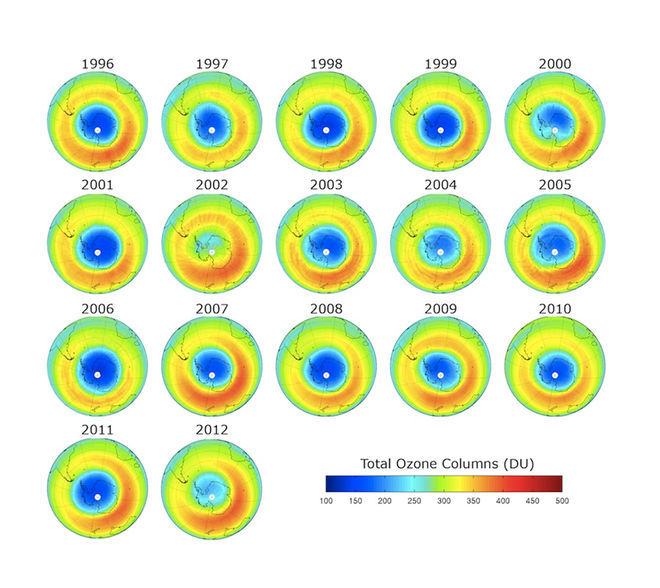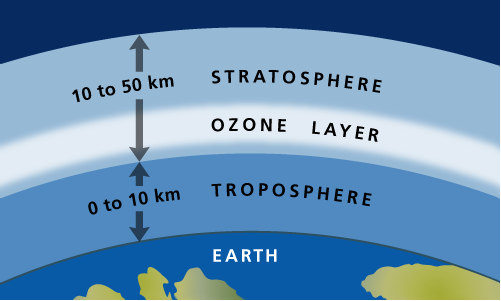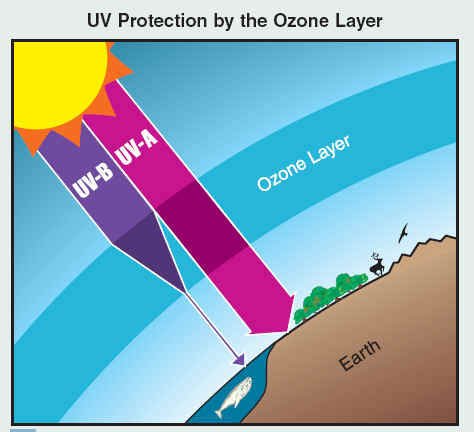The appearance of a rapidly growing hole in the part of the ozone layer over the Antarctic was first reported in the journal Nature in 1985, with later confirmations from NASA’s satellite data. The size of this hole grew rapidly, reaching its maximum size of 29.7million km2 in the year 2000. However, since then and as a result of the Montreal Protocol, an international treaty designed to protect the ozone layer by discontinuing production of the substance responsible for its depletion, the hole over Antarctica has been getting smaller.
 Ozone forms when high-energy ultraviolet (UV) rays from the sun hit oxygen molecules (O2) in our atmosphere, splitting them into single molecules. These then combine with other oxygen molecules to form ozone (O3). By absorbing UV rays in this way, this ‘ozone layer’, found in the stratosphere approximately ten to 50 kilometers above the earth, acts as a protective shield, without which living things could not survive on earth. Partial loss of this protective layer could lead to increased rates of skin cancer in humans and animals.
Ozone forms when high-energy ultraviolet (UV) rays from the sun hit oxygen molecules (O2) in our atmosphere, splitting them into single molecules. These then combine with other oxygen molecules to form ozone (O3). By absorbing UV rays in this way, this ‘ozone layer’, found in the stratosphere approximately ten to 50 kilometers above the earth, acts as a protective shield, without which living things could not survive on earth. Partial loss of this protective layer could lead to increased rates of skin cancer in humans and animals.
The hole is caused by ozone depletion, which occurs when chlorofluorocarbons (CFCs), which were commonly used in spray bottles and as coolants in many refrigerators, are released and accumulate in the atmosphere, breaking down ozone molecules and reducing the stratosphere’s capacity to absorb UV rays.
Rebalancing by God via Humans?
 After the Montreal Protocol, production of CFCs was phased out. The UN estimates that two million cases of skin cancer have been avoided as a result. Unfortunately, the CFCs produced in the 1970s and 1980s are long-lived and remain in the atmosphere for a long time.
After the Montreal Protocol, production of CFCs was phased out. The UN estimates that two million cases of skin cancer have been avoided as a result. Unfortunately, the CFCs produced in the 1970s and 1980s are long-lived and remain in the atmosphere for a long time.
Nevertheless, a report published on June 30, 2016 by researchers from the University of Leeds in the UK and the Massachusetts Institute of Technology (MIT) in the US estimates that the ozone hole could close by the year 2050. The findings suggest that the hole has shrunk by more than 1.7 million sq miles since 2000.
As MIT’s Susan Solomon puts it, “We can now be confident that the things we’ve done have put the planet on a path to heal.”
The presence of the ozone layer in itself is a sign of Allah’s mercy on His creation and His greatness. Its absence would have been detrimental to all living creatures on Earth.
Allah provided complete balance initially. The deleterious results of our transgression on this balance should teach us to appreciate and protect the blessings that have been bestowed on us.
 Allah the Almighty reminds us in the Qur’an: {And the heaven He raised and imposed the balance, That you not transgress (exceed limits) within the balance. And establish weight in justice and do not make deficient the balance} (Surat Ar-Rahman 55:7-9).
Allah the Almighty reminds us in the Qur’an: {And the heaven He raised and imposed the balance, That you not transgress (exceed limits) within the balance. And establish weight in justice and do not make deficient the balance} (Surat Ar-Rahman 55:7-9).
The above verse is a clear indication of the responsibility that is placed on a believer to ensure complete balance and effort to limit as much disruption as possible. Nonetheless, changes with progress are a reality of life. And, indeed, perfection isn’t a facet of this world.
Allah the Almighty mentions in the Qur’an that life in this world will never have a state of perfection. We can only search, seek and work toward constant betterment and perfection, but it will only be achieved in the afterlife.
{But you prefer the worldly life, While the Hereafter is more better and enduring} (Surah Al-A’la 87:67-17).